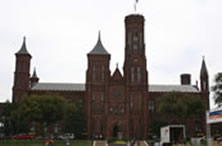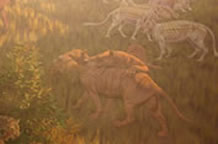Smithsonian Institution
Smithsonite gets its name from James Smithson, who was the illegitimate son of Hugh Smithson (a British nobel, the first Duke of Northumberland). He was born James Lewis Macie, in France in 1765 and later adopted his father's name and became a naturalized British citizen.
Smithson was very interested in chemistry and mineralogy and devoted much of his time to the qualitative analysis of minerals. One of the most significant of his many papers regarding mineralogy was "A Chemical Analysis of Some Calamines." He showed that calamine actually consists of two minerals, zinc oxide and zinc carbonate. It is the zinc carbonate which was later named "smithsonite" in his honor.
Smithson died on June 27, 1829 in Italy and was buried in Genoa. He amassed a sizable fortune during his lifetime which eventually was given "to the United States of America, to found at Washington , under the name of Smithsonian Institution, an Establishment for the increase and diffusion of knowledge..".
This museum is only one of several museums that are included as part of the Smithsonian Institution. There are several art museums, an Indian Museum, a Holocaust Museum, and the very popular Air and Space Museum. The nation's Capital and White House are also nearby. There is so much history in the DC area, that a lifetime is not long enough to see it all.
Two of the last four photos are of replicas. They also have, on display, a replica of the Berlin specimen of the Archaeopteryx. The Smithsonian actually owns the real specimen of the "Running Bird." but has a copy on display. I felt that it was important to show that museums use replicas, even when they actually own the originals. Some people get really hung up on having original specimens. If a museum as prestigious as The Smithsonian Institution is at peace with displaying casts (or replicas), then the average person shouldn't feel too bad about only being able to afford a museum quality copy.
The last photo is of the Hope Diamond. No visit to this particular museum would be complete without seeing this jewel. And there are many many more.
To see some of the other places we have been or other things that we have done, please view other pages in this web site. Also enjoy the products and information on this web site. New additions, and updates, are made to the site monthly.
Thank you for visiting.

Front of main building.

Fossil sea mount diorama.

Large crinoid display .

Very large trilobite display.

Sea floor diorama.

Dunkleosteus mural.

Xiphactinus skeleton.

T-rex & Diplodocus? skeletons.

Eocene mural.

Eocene mural and skeletons.

Back of main building.

Coelacanth.

Crinoid plate, see center at left.

Large trilobite track plate.

Fossil ammonite display.

Mosasaur mural & skeleton.

Eurypterid diorama.

Life size Stegosaurus model.

Replica of wading bird.

The real Hope Diamond.

Entrance to science museum.

Piece of real fossil sea mount.

Label for above fossil.

Cephalopod diorama.

Mural with turtle & pliosaur.

Mosasaur mural & bird skeleton.

Dimetrodon skeleton.

Diatryma skeleton.

Replica of "the running bird."